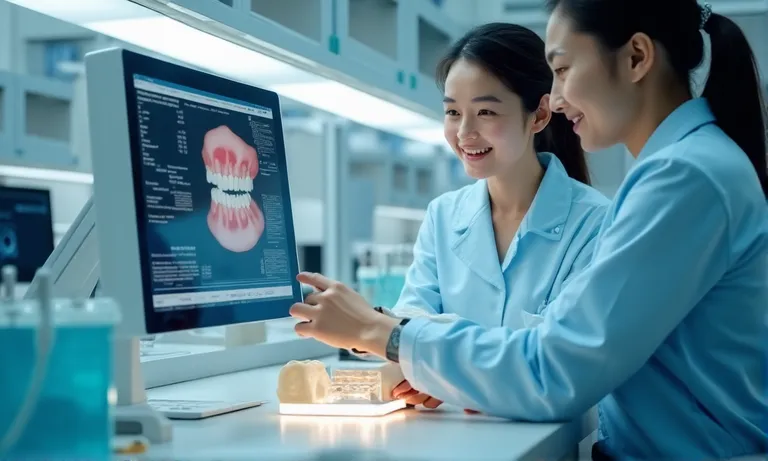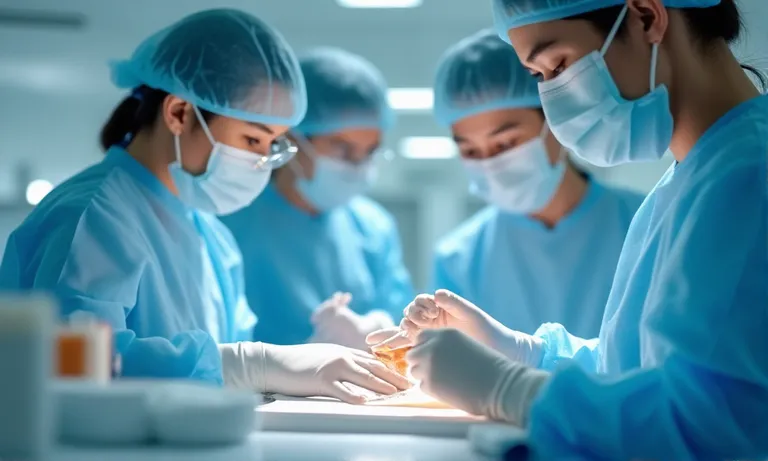Choosing between a local dental lab and an outsourced production partner is no longer just a geographic decision—it’s a strategic choice shaped by turnaround speed, digital integration, communication flow, and cost predictability. For dental buyers aiming for consistency and scale, the decision requires balancing operational control with system maturity.
Procurement teams typically assess five core factors when comparing options:
Turnaround Time & Delivery Reliability
Local labs often provide faster case returns and better responsiveness for urgent needs. Outsourcing, by contrast, requires proactive planning for cross-border shipping and customs timelines.
Digital Workflow Compatibility
Specialized outsourcing labs offer robust CAD/CAM systems, portal-based file access, and SLA-backed tracking. Local labs, however, may provide quicker file adjustments and hands-on feedback for early-stage digital adopters.
Communication and Case Coordination
Physical proximity enables immediate updates and real-time case clarification. Offshore partners need to bridge time zone differences through structured portals and defined communication protocols.
Cost and Volume Scalability
Outsourced labs can reduce per-unit costs and offer tiered pricing across materials and case types. Local labs may charge more but offer agile handling for low-volume or highly customized cases.
Quality Assurance and Accountability
Key evaluation criteria include remake rates, material transparency, and documentation quality. Trial cases and onboarding protocols are essential to validate consistency under real workflow conditions.
Rather than defaulting to one model, successful buyers conduct structured side-by-side comparisons based on performance data, system compatibility, and long-term workflow alignment.
What Are the Key Advantages of Working with a Local Dental Lab?
Working with a local dental lab offers faster turnaround times, closer collaboration, and greater control over cases—especially for urgent or customized restorations. When clinics prioritize speed, in-person feedback, and material visibility, a nearby lab can significantly streamline communication and increase operational certainty. However, these advantages often depend on the lab’s infrastructure and digital maturity.

Local-Dental-Lab-In-Person-Consultation
How does proximity reduce turnaround time and improve urgent case handling?
Physical closeness often translates to hours saved in transportation, coordination, and last-minute adjustments. Local labs can offer same-day pickup or hand delivery, which is nearly impossible with cross-border shipping. This flexibility is especially valuable when handling fractured temporaries, aesthetic shade matching, or remakes required before patient reappointments.
- Same-day logistics: Many local labs use bike couriers or even front-desk handoffs to speed delivery.
- Rapid adjustments: Minor corrections can be reworked and returned within hours.
- Reduced shipping variability: No customs, delays, or timezone misalignments.
- Improved patient satisfaction: Clinics can deliver quicker outcomes with less rescheduling.
Can in-person collaboration enhance digital file accuracy?
In-person interaction allows real-time clarification, which is particularly helpful for margin lines, bite registration, and scanner integration quirks. When clinics and labs operate within driving distance, physical visits, live demos, or real-time joint file reviews are possible—even if most workflows are digital-first.
- Direct feedback loops: Immediate feedback between dental team and technician
- Scanner compatibility checks: In-person calibration of scanners or bite scan alignment improves long-term accuracy
- Chairside assistance: Some local labs offer on-site troubleshooting or clinical backup
- Better onboarding: First-time collaboration is smoother when technicians understand the clinic’s typical scanning habits and case types
- Read more on intraoral scanner compatibility challenges and how they impact lab workflows.
Do local labs allow more direct control over workflow and materials?
Local labs often provide clinics with more hands-on influence over materials, case priority, and aesthetic decisions. Especially for practices with strong internal protocols, the ability to inspect materials in person, verify shade tabs, or discuss options with technicians helps bridge the gap between lab and chair.
- Material transparency: Easy to confirm which zirconia, metal, or resin is being used
- Case escalation: Priority cases can be pushed through with direct contact
- Aesthetic previews: Clients can request photos, prototypes, or in-person preview try-ins
- Workflow customizations: Labs are more likely to accommodate preferred checklists, scan formats, or communication habits
✅ Face-to-face collaboration improves confidence and speeds resolution — TRUE
Clinics gain real-time assurance on design and case direction when working closely with technicians.
❌ Digital files eliminate the need for lab communication — FALSE
Digital systems require precise coordination and frequent confirmation, especially across unique platforms or scanner brands.
What Are the Major Benefits of Outsourcing to Specialized Digital Labs?
Outsourcing to specialized digital dental labs provides advanced technology access, cost efficiencies, and scalable workflows that many local labs struggle to match. For clinics managing high case volumes or requiring precision in implant planning, digital outsourcing labs offer a structured, repeatable, and cost-effective alternative. These benefits are especially evident in clinics pursuing full digital integration.

Digital-Dental-Lab-Technician-Handling-Multi-Screen-Zirconia-Cases
How do specialized labs deliver technology-driven precision and scalability?
Digital outsourcing labs often operate on integrated CAD/CAM systems, enabling high repeatability, consistency, and complex case planning. They invest in software licenses, scanner compatibility, milling units, and post-processing workflows that allow for smoother digital integration than many local labs.
- Advanced CAD/CAM workflows: Full-arch or implant-supported restorations benefit from predictable outputs
- Consistent shade libraries and nesting: Reduced color variation and material waste
- Precision milling centers: Industrial-scale equipment offers micron-level tolerance
- Cross-platform file handling: Specialized teams are trained to adapt to most IOS systems
- Explore how AI-enhanced dental CAD tools optimize precision and repeatability in lab output
Can outsourcing reduce overhead and provide volume price advantages?
Outsourced labs often consolidate costs across clients, resulting in economies of scale unavailable to smaller or local operators. By standardizing case types and distributing labor across digital workflows, they can reduce per-unit costs while offering transparent pricing tiers.
| Comparison Area | Local Lab Average | Outsourced Digital Lab |
|---|---|---|
| Single crown unit price | $110 – $140 | $65 – $90 |
| CAD design included? | Sometimes extra | Included |
| Implant complexity pricing | Tiered/manual | Standardized workflows |
| Remake policy | Case-by-case | SLA-based, documented |
- Lower cost doesn’t imply lower quality — it reflects scaled infrastructure
- Pricing is often more predictable and process-based
- SLA-driven models support clearer expectations for remake handling
Do expert teams improve support for complex digital workflows?
Specialized digital labs typically employ technicians with segmented expertise—CAD designers, CAM operators, QA teams—which enhances quality assurance across high-demand workflows. Instead of generalists juggling multiple roles, these labs invest in team structures that mirror enterprise standards.
- Dedicated support teams: Technicians assigned by product type or complexity
- Version control systems: Prevent outdated STL usage or duplicated cases
- Client success roles: Some labs offer account-level case managers
- Faster onboarding: Structured handoff procedures reduce back-and-forth
- Learn how digital lab team structure improves predictability in implant cases via this industry breakdown
✅ Digital outsourcing offers repeatability, cost control, and access to expert segmentation — TRUE
These advantages are particularly evident for clinics handling complex or bulk cases.
❌ Outsourced labs are only useful for basic restorations — FALSE
Most specialized digital labs excel at complex multi-unit, implant-supported, or esthetic-sensitive restorations with greater consistency than small local teams.
What Drawbacks Should You Expect from Outsourced Labs?
While outsourcing to dental labs offers scalability and cost benefits, it introduces challenges around communication, compatibility, and cross-border logistics. These issues aren’t always deal-breakers—but they do require workflow maturity, proactive planning, and clear protocols to ensure consistent results.

Global-Dental-Lab-Shipping-Cross-Border-Tracking
How do communication latency and time zones affect case delivery?
Working across time zones can slow down feedback loops, especially when urgent corrections or design changes are needed. Some outsourced labs operate 6–12 hours ahead or behind clinics, making real-time back-and-forth difficult unless protocols are clearly defined.
- Email cycles get delayed: A revision request may not be seen until the next business day
- No real-time contact: Unless scheduled in advance, live calls are often missed
- Issue resolution lag: Delays in approving design or case holds can affect patient delivery
- Language barriers: Although most labs use English, subtle nuances in instructions may be misread
Are file compatibility or version issues more likely offsite?
Compatibility issues can emerge when scanner exports, file formats, or lab software versions aren’t fully aligned—especially if the lab uses a different design ecosystem. Without shared calibration protocols or scanner model awareness, unexpected artifacts or marginal gaps may appear.
- Non-standard STL exports: Scanner firmware updates may cause STL metadata mismatches
- No feedback portal: Some outsourced labs lack real-time viewer systems for margin feedback
- Design delays: A simple export error can delay design by a full day
- Less context sharing: Case notes may not transmit with digital files if systems aren’t linked
- This technical breakdown on intraoral scanner and lab software interoperability explains the source of common errors
Can shipping delays or customs complicate timelines?
Logistics delays are an unavoidable risk when working across borders—ranging from courier backlogs to customs holds. Even express services may encounter unpredictable events that disrupt otherwise well-planned delivery schedules.
- Weather or customs inspections: May add 24–72 hours to expected delivery time
- Inaccurate shipping declarations: Risk of temporary holds or tariff issues
- No in-hand rework: A local remake fallback is often unavailable, increasing pressure to get it right the first time
- Delivery tracking reliance: Clinics must be diligent about monitoring handoff status
✅ Cross-border workflows require clear expectations and risk buffers — TRUE
Proactive coordination can significantly reduce the impact of timezone and logistics friction.
❌ Once outsourced, labs handle everything without input — FALSE
Active participation from the clinic remains crucial in managing design approvals, file quality, and delivery timelines.
How Should Buyers Compare Local vs Outsourcing in a Digital Workflow Context?
To make an informed choice between local and outsourced dental labs, buyers must evaluate digital compatibility, turnaround reliability, and workflow validation options—not just pricing. A structured comparison of technical integration, SLA commitments, and trial case protocols helps clinics and DSOs align lab partnerships with long-term operational goals.

Image
ALT: Digital-Lab-Comparison-Workflow-Dashboard
Prompt: A highly realistic, ultra-detailed, professional-quality image showing a split-screen of two dental workflow dashboards: one from a local lab showing manual logs, and another from an outsourced digital lab displaying live SLA tracking, scanner input, QA checklist, and delivery status. The lighting is clean and white, emphasizing modern vs analog differences.
What technical compatibility factors are critical in each case?
File format alignment, scanner integration, and shared design protocols determine how seamlessly a clinic can collaborate with a lab. When systems mismatch—even slightly—delays, misinterpretations, and remakes often follow.
- Scanner model support: Can the lab process scans from your IOS, Trios, or Medit system?
- Margin marking + viewer tools: Do both sides have the ability to view and annotate margin lines in the same portal?
- Version consistency: Are both ends using compatible CAD/CAM software releases?
- Digital checklist compliance: Does the lab follow your scan protocol preferences (e.g., opposing arch, bite, labeling)?
How should turnaround SLA and delivery consistency be weighted?
A lab’s ability to meet stated delivery windows—especially during peak volume—has a direct impact on clinical scheduling and patient satisfaction. Look beyond average turnaround times and evaluate SLA enforcement, consistency, and escalation mechanisms.
| SLA Attribute | Local Lab (Typical) | Outsourced Digital Lab (Standard) |
|---|---|---|
| Turnaround visibility | Manual updates, emails | Live tracking dashboard |
| SLA guarantee | Informal or verbal | Written SLA (48–72hr standard) |
| Peak load handling | Bottleneck-prone | Load balanced across teams |
| Remake escalation | Ad hoc or by request | Structured with defined timelines |
- Evaluate based on consistency, not just speed
- Labs with dashboards or performance logs reduce guesswork
- SLA breach handling matters more than best-case delivery
Can trial orders help validate workflow maturity across both options?
Before committing to a full-scale partnership, clinics should run a structured trial covering multiple case types and digital conditions. This reveals gaps in compatibility, communication, and responsiveness without risking large patient volume.
- Select a test case set: Include at least one crown, one implant, and one esthetic case
- Submit with varied scanner formats: Use multiple sources if available (e.g., IOS + Trios)
- Track delivery variance: Log time from upload to receipt, remake rate, and adjustment required
- Assess feedback quality: Was design feedback clear, actionable, and on-time?
- Compare documentation: Did each lab provide traceable logs, QA visuals, and follow-ups?
✅ Digital lab comparisons should prioritize technical fit and workflow reliability — TRUE
Without compatibility and consistent delivery, even low prices can’t prevent clinical disruption.
❌ A lab’s location is more important than its system integration — FALSE
In digital workflows, file compatibility, SLA performance, and team responsiveness matter more than proximity.
What Questions Should You Ask When Choosing Between Local and Outsourced Labs?
To evaluate dental lab partners effectively, buyers should use a structured set of questions covering communication, pricing, turnaround, material options, and quality metrics. A well-designed checklist ensures decisions are based on repeatable performance criteria—not just assumptions or geography.

Dental-Lab-Comparison-Checklist-Screen
Can you compare portal transparency, communication responsiveness, and SLA support?
| Evaluation Area | Local Lab | Outsourced Digital Lab |
|---|---|---|
| Case tracking portal | Rare; typically via phone/email | Yes; real-time dashboard, timestamps |
| Response time (in urgent cases) | Same-day possible in person | Scheduled response, timezone-sensitive |
| SLA documentation | Often verbal | Formal SLA policy with escalation rules |
| Communication method | Calls, personal visits | Structured email, messaging, portal logs |
- Ask: How will I track this case once it leaves my chair?
- Ask: What happens if I don’t get feedback within 24 hours?
- Ask: Can I escalate an urgent case and how is it logged?
What are comparative costs, material options, and turnaround timelines?
Labs differ significantly in pricing models, material sourcing, and turnaround control. Hidden charges, tiered case pricing, or inconsistent material substitutions may all impact your long-term satisfaction.
- Does the quote include CAD design or is it extra?
- What zirconia brands or alloy grades are available?
- How are rush fees handled and is the delivery date guaranteed?
- Is the turnaround time a goal, or a committed SLA?
How are quality metrics like remake rate tracked locally vs offshore?
High remake rates often point to deeper workflow or communication breakdowns—and labs that track and share these numbers transparently show more operational maturity.
- Do you track remake rates by case type and material?
- What’s your average annual adjustment rate?
- Do you log first-time pass rate for full-arch cases?
- How are remake requests documented and escalated internally?
✅ Asking the right questions reveals deeper alignment than pricing alone — TRUE
A clear evaluation process builds trust and exposes potential risks before they escalate.
❌ Choosing a lab is just about finding the lowest cost — FALSE
Labs with better process visibility and quality control often prevent expensive clinical consequences later.
How Raytops Supports Clients Considering Outsourced Lab Collaboration
Raytops Dental Lab supports digital lab buyers through a structured onboarding process, transparent material-pricing policies, and SLA-driven international coordination. Rather than emphasizing sales, we focus on being a responsive, technically capable partner for clinics and DSOs navigating full or partial digital outsourcing transitions.

Raytops-Digital-Onboarding-Workflow
Digital compatibility checks and file onboarding
We begin each collaboration with compatibility tests across scanner types, file formats, and design software versions. This ensures that the clinic’s intraoral scanner data integrates smoothly into our CAD/CAM production flow, minimizing guesswork or rejections.
- File type mapping: We test support for .STL, .PLY, and proprietary IOS outputs
- Margin visualization feedback: Our design team offers marked screenshots for doctor confirmation
- Onboarding documentation: Each new client receives a file setup guide, scanner checklist, and common fixes reference
- Turnaround simulation: We can simulate a full case cycle before formal engagement
Volume-friendly pricing, material transparency, and performance metrics
Raytops offers volume-based pricing tiers and clear documentation of materials used, along with real-time access to SLA metrics and issue logs. This creates pricing predictability and traceability in ongoing collaboration.
| Service Component | Our Approach |
|---|---|
| Zirconia sourcing | Identified by brand and strength class (e.g., HT, STML) |
| Unit pricing | Transparent across crowns, implants, temporaries |
| SLA tracking | Available per case via shared dashboard access |
| Remake policy | Linked to technical thresholds, with issue tagging |
| Volume discounts | Tiered pricing visible from initial onboarding |
- No hidden material substitutions
- Full performance metrics are shared during onboarding
- Clinics retain visibility across design, production, and shipping stages
Cross-border coordination, communication SLAs, and delivery tracking
To mitigate timezone and customs risks, we align each client with a dedicated account handler, define SLA expectations, and integrate live shipping coordination.
- Timezone response map: Our team provides realistic response windows by region
- Multichannel support: We offer email, Slack, and portal communication depending on client preference
- Shipping milestone tracking: All cases are labeled, timestamped, and traceable via DHL or FedEx
- Escalation protocol: For remakes or urgent cases, we flag and reprioritize production within agreed turnaround margins
At Raytops, we focus on digital compatibility, operational visibility, and accountable support—so our partners can scale with confidence.
From onboarding to daily case handling, we aim to remove uncertainty and deliver trust through predictable execution.
Conclusion
Choosing between a local and outsourced dental lab isn’t about location—it’s about alignment.
From digital compatibility and turnaround consistency to communication flow and quality assurance, the real differentiator lies in how well a lab integrates with your digital workflow and supports your clinical standards.
Local labs offer immediacy and hands-on control, while outsourced partners—when structured properly—provide scale, technology, and repeatability. Smart buyers evaluate labs based on system integration, performance metrics, and real-world responsiveness, not just cost or distance.
At Raytops, we don’t believe in one-size-fits-all. Instead, we support clinics and DSOs with predictable digital onboarding, transparent collaboration protocols, and infrastructure built for cross-border success.
If you’re exploring lab partnerships beyond borders, start with compatibility, not commitment—let your first few test cases validate the future.


